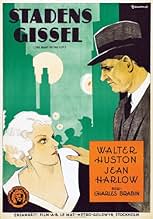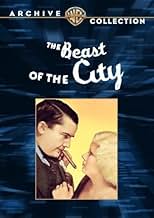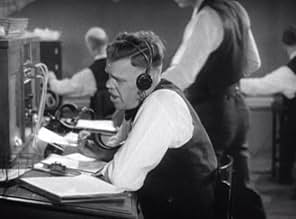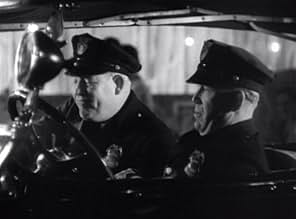Ajouter une intrigue dans votre languePolice Chief Jim Fitzpatrick ruthlessly goes after organized crime and is prepared to use brutal and violent methods to fight it.Police Chief Jim Fitzpatrick ruthlessly goes after organized crime and is prepared to use brutal and violent methods to fight it.Police Chief Jim Fitzpatrick ruthlessly goes after organized crime and is prepared to use brutal and violent methods to fight it.
- Réalisation
- Scénario
- Casting principal
- Detective
- (non crédité)
- Mayor
- (non crédité)
- Turnkey
- (non crédité)
- Police Dispatcher
- (non crédité)
- Policeman #5 on Telephone
- (non crédité)
- Pat - Car 47 Driver
- (non crédité)
- Joel - Policeman Outside Car 47
- (non crédité)
Avis à la une
Taken from a story by "Little Caesar" author, W.R. Burnett, the fade-in follows the daily routine of the New York City police department through its camera tracking starting with police operators(one being Edward Brophy) taking, receiving or gathering information from phone calls before "calling all cars" to policemen in their siren blazing patrol cars racing down the streets to their latest assignments. James J. Fitzpatrick (Walter Huston) is introduced as a police captain whose failing methods in putting gang leader, Sam Belmonte (Jean Hersholt) in prison due to lack of evidence, assisted by a corrupt lawyer (Tully Marshall) who gets him released on technicality, gets himself demoted to desk job at a quieter precinct at the other side of town by his chief commander (Emmett Corrigan). Fitzpatrick, a family man with wife, Mary (Dorothy Peterson), twin daughters (Betty Mae and Beverly Crane) and son, Mickey (Mickey Rooney), redeems himself by capturing a pair of robbers, that reinstates his position as police chief. As Fitzpatrick continues his attempt to put an end of Belmonte's racketeering activities, Ed (Wallace Ford), his younger brother and detective in the police force, who, while on assignment, falls victim to Daisy (Jean Harlow), Belmonte's "stenographer" and mistress, Unable to obtain a promotion, Ed foils his brother's chances with his fight against crime.
Other members of the cast include: John Miljan (District Attorney); Sandy Roth (Lieutenant John "Mac" McGrowski); J. Carroll Naish (Pierre Choco, one of Belmonte's mob); Murray Kinnell (The Judge). There's also those familiar faces of character actors as George Chandler, Clarence Wilson, Arthur Hoyt and Nat Pendleton appearing in smaller roles.
Virtually forgotten following its very limited television broadcasts since the 1960s, this pre-code crime melodrama, which surfaced decades later in the wake of cable television on Turner Network Television (TNT) in the late 1980s before becoming a prominent fixture on Turner Classic Movies (1994 onward), THE BEAST OF THE CITY, being Walter Huston's movie from start to finish, is recognizable mostly for its presence by the second-billed Jean Harlow, still early in her career. For her second MGM film, the studio where she would remain until her untimely death in June 1937, is basically secondary than a major presence. She does make the most of it doing her part of a tough talking blonde. Harlow's character is introduced briefly in Belmonte's office with no spoken dialogue before coming forth minutes later in the police line-up where she captures the attention of the weakling brother (Ford) to a crime fighter (Huston). Though the Danish-born Hersholt may seem miscast as the Italian ring-leader, possibly John Miljan, probably tiring of his bad guy image by this point (cast as a gray-haired attorney), might have been better suited. Or Tully Marshall switching with Hersholt. Of its assemble, much of the cast is well placed in their roles, especially Walter Huston who can play bad guys, good guys or anti-heroes with conviction without any chance of being type-cast.
Once seen, whether on DVD or TCM viewing, it's hard to forget some of the violence (by 1932 standards) attached to THE BEAST OF THE CITY, along with its offbeat and dark method to Fitzpatrick's fight against crime. This is his story. This is MGM's contribution to the American policemen. This is Hollywood's participation to crime wave on the city streets, quite different, quite atypical from anything else regards to cops and gangsters up to this level. (***)
The film also borrows a lot from westerns at the time. Huston's unknown western city is ruled by gangster Jean Hersholt who is apparently untouchable as far as the law is concerned. A whole lot like real life gangsters Al Capone and Lucky Luciano who were coming into prominence.
Huston's family life is secure enough, wife Dorothy Peterson, a few kids among them a young Mickey Rooney. He also has his younger and weaker brother Wallace Ford living with them. Ford's got a real good deal, no rent and he apparently chases a lot of skirts. That proves to be his downfall and eventually Huston's.
The skirt that did them in belonged to Jean Harlow. Jean was never a better mantrap in her career than she is The Beast Of The City. Wallace Ford turns out to be putty in her hands.
Also note another good performance in The Beast Of The City is that of Tully Marshall who plays Hersholt's lawyer. The word shyster was invented for lawyers like Marshall, but he's good to have on your side especially if you're guilty as sin.
The climax is an unforgettable one and one more typical to a western than a modern drama. It's what makes The Beast Of The City a classic that is too rarely seen today.
*** (out of 4)
MGM gangster film shown from the point of view of the police. Capt. Fitzpatrick (Walter Huston) is out to bring down gangster Sam Belmonte (Jean Hersholt) but is sold out by his brother (Wallace Ford) who has fallen for the gangster's girl (Jean Harlow). This film is certainly a lot different than the Warner gangster pictures as it doesn't glamorize the gangsters but instead puts the spotlight on the public for allowing gangs to rule the streets. Huston is his usual fiery self and both Ford and Harlow shine in their supporting roles. The subplot between Ford and Harlow is a bit weak but it leads to a highly powerful ending, which is among one of the best scenes from all the gangster films from this period.
Le saviez-vous
- AnecdotesMickey Rooney had just turned 11 years old when he played Walter Huston's young son in his first full-length sound feature film. His character's name is also "Mickey," and his first line is, "Say, those don't look like pancakes!"
- GaffesWhen Ed and Daisy first kiss, in a medium shot, he's holding her head in the crook of his left arm, and her right had is on his side. In the next closer shot, his arm is down and her right hand is up on his lapel.
- Citations
Daisy Stevens, aka Mildred Beaumont: [Ed grabs her arm tightly] Say! That hurts a little bit.
Det. Ed Fitzpatrick: And you don't like to be hurt, do you?
Daisy Stevens, aka Mildred Beaumont: Oh, I don't know.
[Suggestively]
Daisy Stevens, aka Mildred Beaumont: Kinda fun sometimes if it's done in the right spirit.
Det. Ed Fitzpatrick: [Pushes her away] Get the beer!
- Crédits fousOpening card: Instead of the glorification of cowardly gangsters, we need the glorification of policemen who do their duty and give their lives in public protection. If the police had the vigilant universal backing of the public opinion in their communities, if they had the implacable support of the prosecuting authorities and the courts, I am convinced that our police would stamp out the excessive crime, which had disgraced some of our great cities. ---- President Herbert Hoover
- ConnexionsFeatured in Harlow: The Blonde Bombshell (1993)
- Bandes originalesChopsticks
(1877) (uncredited)
Traditional piano tune
Music by Euphemia Allen
Played on piano by Betty Mae Crane and Beverly Crane
Meilleurs choix
- How long is The Beast of the City?Alimenté par Alexa
Détails
- Date de sortie
- Pays d’origine
- Langue
- Aussi connu sous le nom de
- The Beast of the City
- Lieux de tournage
- 3849 Main Street, Culver City, Californie, États-Unis(robbery at the Bank of America branch)
- Sociétés de production
- Voir plus de crédits d'entreprise sur IMDbPro
Box-office
- Budget
- 230 000 $US (estimé)
- Durée1 heure 26 minutes
- Couleur
- Rapport de forme
- 1.37 : 1
Contribuer à cette page





































